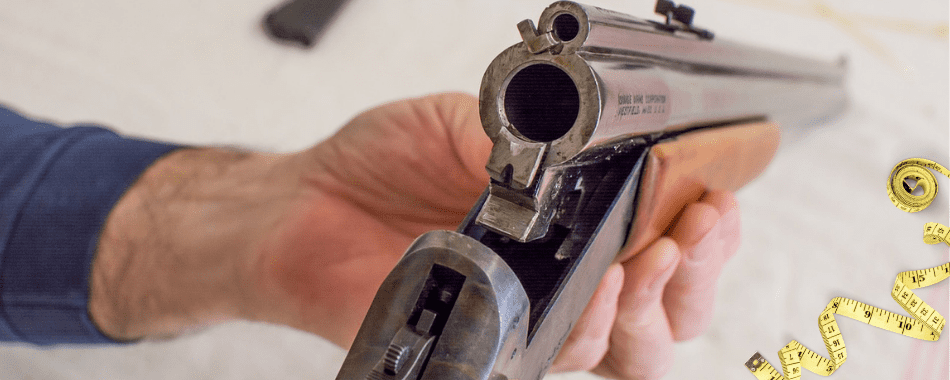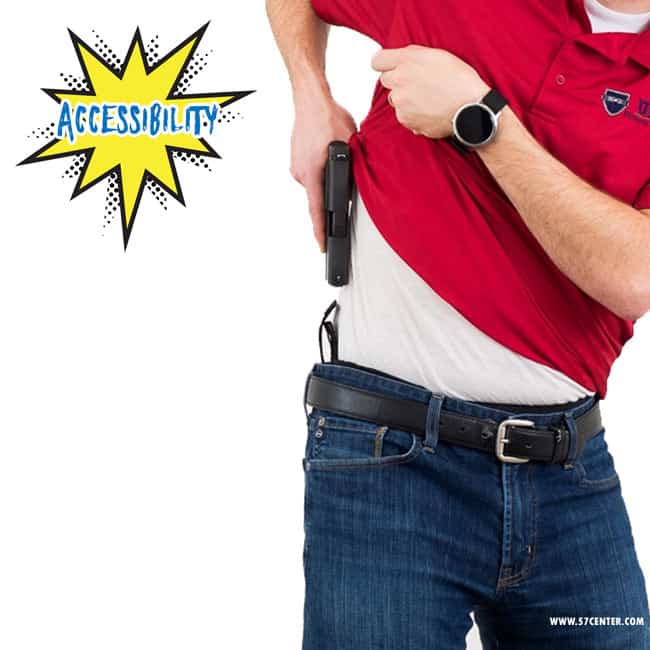
Ah, the holster. The right-hand man to your concealed carry weapon. If you’re looking for information on rifles, this isn’t the right place. Today, we will be focusing on pistols and holsters. Finding the perfect fit holster is just as important as finding the perfect pistol; they work hand in hand with each other. A lot of gun owners struggle to find a holster fit that gives good concealment and still functions well as a carry holster. Why is that?
One word: measuring. What’s the most important part of your firearm? You might think of the caliber, trigger guard, or even a spare magazine. But most gun owners would probably say the barrel. Which, I would have to agree with. The barrel is what aims and shoots your firearm, and is essentially what the weapon revolves around to make it work.
Gun holsters are usually tailored to specific handguns, meaning that the measurements are mind with a certain type of weapon in mind for that particular holster. That way, if you buy the right holster set, you’ll get the perfect fit every time. But, in order to do that, you’ll need to measure the main component of your handgun: the barrel.
Contents
Why Does Barrel Length Matter?
Handguns are often sorted by their size. Different barrel lengths will matter when it comes to performance, holstering, and even competitive shooting. Different barrels, like a threaded barrel, can also contribute to different barrel lengths. The length can also dictate what the weapon is intended to be used for, whether that’s for official law enforcement or just for the average concealed carry permit. Concealment is also a major factor that can be affected by the barrel dimensions. Holster Accessories can vary depending on the size, which can affect what you may have to purchase in order to properly conceal your weapon when needed.
Weight
Since the gun barrel is such a large component, it often has a great influence on the total weight of your pistol. A barrel that is excessive in length can result in a handgun that is forward heavy, meaning that it tends to try and tip forward when you are aiming. This can make it difficult to maintain an accurate aim when you’re trying to fight the sheer weight of your weapon.
Also, a semi automatic pistol will usually have a longer slide, which is attached to the top of the barrel. The longer the barrel the longer the slide. This of course, will add even more to the weapon’s weight since the slide is another crucial part of the gun.
Accuracy
Most gun owners don’t have a fully decked-out, military style pistol. So, chances are, you’re just using the plain old iron sights. Which is great, but can also be affected by the barrel length. When using your iron sights, there’s a certain amount of distance between the front and rear sights depending on the barrel size. The longer this distance is, the greater chance of deflection, which is basically just deviation from your perfect alignment. So, the longer the barrel, the greater chance you have of being more inaccurate with your iron sights.
Concealment
This is the most important point of today’s discussion. Concealed carry. When measuring your barrel for a holster, you’ll want the most concealment as possible, hence the “concealed carry.” The barrel of the gun is the part that goes and sits inside the holster, so that is the main part that you’ll be aiming to hide.
This is why it’s so important to measure your barrel. If your barrel is super long, you might have a harder time trying to conceal it than a shorter barrel, so you might have to compensate for that when you go to purchase your holster. If you have a shorter barrel, your handgun will be more easily concealed. Either way, knowing the exact length of your barrel is important for a perfect fit and a good concealment job.
Carry
This goes along with the concealment category. While you want to conceal your weapon, that also means that you should be able to carry it comfortably in the style that you choose. A long and heavy barrel will add more weight, and will therefore make it less comfortable and easy to carry. If you’re using a waistband holster, it can drag your belt or pants down. With an ankle holster, it can be very difficult to walk with. This is why most experienced concealed carry gun owners go for a pocket pistol or a carry gun, which is much smaller and lighter and made specifically for this reason.
Measuring Your Barrel
Measuring your barrel sounds pretty easy, right? I mean, yes, but it’s also very important that you do it exactly right in order to get the best holster fit. A lot of people might refer to their gun manual, which is a great idea, but might not be accessible for everyone. So, if you can’t read the product description, learning how to measure your own barrel is a good skill to have. So, let’s break down the steps you can take to get a perfect fit for your holster.
Use a Ruler or Tape Measure

The first and probably most obvious way to measure the weapon is with a ruler or a tape measure. Now, this sounds simple, but there’s specific spots that you’ll need to measure from in order to get the right holster size.
For a typical pistol, you’ll want to measure between the muzzle and the back of the chamber. Where you’ll be measuring will depend on the type of gun that you have. For a revolver, you’ll measure between the muzzle and the back of the forcing cone.
While this method is the most familiar and simple, it’s not the most recommended just because it’s not the most accurate. There’s related products out there that are made specifically for barrel measuring that you might want to take a look at before you settle on just one measurement.
Use a Caliper

A specifically designed tool is a caliper. A caliper is a measuring device that is designed to take the diameter and size of the inside and outside of the barrel. This method is much more accurate and reliable than just using a tape measure. If you can get your hands on one, I would definitely recommend it.
First, place the caliper around the outside of the barrel. Tighten it so that it fits nicely around the weapon and take the measurement of the caliper. Then, repeat for the other side of the barrel. Once you have the 2 measurements, average them together and you have your barrel size. This method is much more accurate and is backed by experienced gun owners and groups like the ATF.
Use a Dowel Rod

This is by far the best and most accurate measuring method you can do. A measuring rod or a dowel rod will be inserted into the barrel of your gun and that is what will be used to give you the most precise barrel measurement. However, you can only use this tool on handguns that have an integrated chamber, like a semi automatic pistol. Weapons like a revolver, that have an open chamber, will not need a measuring rod.
To use this, insert the dowel rod into your barrel. The rod must be smaller than the diameter of the barrel. Make sure the slide is closed when you insert the dowel rod. Push the rod down until it touches the breech face of your weapon. This is the recommended distance from the ATF to measure your barrel from.
Using a marker, mark down the end of the muzzle on the rod and pull it out. Now, you have the dowel rod with a mark on it to indicate exactly how long your barrel is. This method is relatively easy and gives a very accurate (and the ATF’s approval) measurement.
For a revolver, this won’t be necessary. Simply take your ruler or measuring tape and measure from the end of the muzzle to the beginning of the cylinder chamber. This will give you an accurate measurement.
Step-by-Step Guide to Measuring a Gun Barrel
Follow these steps to measure your gun barrel for a holster:
- Clear the Firearm
Before handling the firearm, ensure it is unloaded and follow proper safety protocols.
- Measure the Overall Length
Using a tape measure or ruler, measure the total length of the gun barrel from the breech face to the muzzle. Note down the measurement in inches or millimeters.
- Measure the Inner Diameter of the Holster
Using calipers, carefully measure the inner diameter of the holster. This measurement should match the outer diameter of the gun barrel for a secure fit. Ensure the holster accommodates any additional attachments or accessories, such as suppressors or muzzle brakes.
- Consider Retention Mechanisms
If your holster has retention mechanisms like adjustable tension screws or locking devices, make sure they are compatible with your firearm. Adjust them accordingly to achieve the desired level of retention while maintaining a smooth draw.
Choosing the Right Holster Size
When selecting a holster, consider the following factors:
A. Firearm Type and Model
Different firearms have unique dimensions and shapes. Ensure the holster you choose is specifically designed for your firearm make and model.
B. Holster Type
Consider the intended use of the holster. Holsters vary in their design, such as inside-the-waistband (IWB), outside-the-waistband (OWB), shoulder holsters, or ankle holsters. Each type has different requirements for gun barrel measurement and fitting.
C. Concealment and Comfort
Decide whether you prioritize concealment or comfort. Some holsters offer better concealment, while others prioritize comfort during extended wear. Choose the one that suits your needs and preferences.
Exploring Different Types of Holsters
There are various types of holsters available, each catering to different preferences and carry methods:
A. Inside-the-Waistband (IWB) Holsters

IWB holsters are worn inside the waistband, providing excellent concealment. They offer a snug fit against the body and are ideal for individuals who prefer discreet carry.
B. Outside-the-Waistband (OWB) Holsters
OWB holsters are worn outside the waistband, offering easy access and a comfortable carry position. They are popular among competitive shooters and open-carry enthusiasts.
C. Shoulder Holsters

Shoulder holsters are worn on the shoulder and allow for a horizontal draw. They distribute the weight of the firearm and accessories, making them suitable for individuals who need to carry larger firearms.
D. Ankle Holsters
Ankle holsters are strapped around the ankle, providing a concealed carry option. They are typically used as backup holsters or for individuals who can’t carry on the waist.
Common Mistakes to Avoid
When measuring a gun barrel for a holster, avoid the following common mistakes:
- Inaccurate Measurements
Ensure your measurements are precise, as even slight deviations can lead to an ill-fitting holster.
- Neglecting Accessories
If you plan to use additional accessories like suppressors or muzzle brakes, account for their dimensions when measuring the gun barrel.
- Overlooking Retention Requirements
If you require a higher level of firearm retention, select a holster with appropriate retention mechanisms.
- Ignoring Comfort and Concealment
Balance your preferences for comfort and concealment when choosing a holster. Consider your daily activities and clothing choices to find the right balance.
Conclusion
Measuring a gun barrel for a holster is crucial to ensure a secure, comfortable, and accessible carry. By following the step-by-step guide and considering the factors discussed, you can select the right holster size and achieve a proper fit. Remember to prioritize safety, and always adhere to local laws and regulations regarding firearm carry and holsters.
FAQs
- What is the best material for holsters?
- Can I use the same holster for multiple firearms?
- It is generally recommended to use a specific holster designed for the make and model of your firearm. Universal holsters may not provide the same level of secure fitment.
- Are there any alternatives to traditional holsters?
- Yes, alternatives include pocket holsters, belly bands, and specialized clothing with built-in holsters. Choose an option that suits your needs and offers a safe and comfortable carry method.
- How often should I measure my gun barrel for a holster?
- It is advisable to measure your gun barrel whenever you plan to purchase a new holster or if you make any modifications to your firearm that may affect its dimensions.
- Can I make my own holster?
- Crafting a holster requires specific knowledge and skills. If you’re considering making your own holster, thoroughly research the process, ensure compliance with local laws, and prioritize safety.
References

Brian Belko is a freelance writer and blogger. His primary areas of focus include the outdoors and shooting sports. In addition to his freelance work, Brian also writes for Wide Open Spaces and is on the Pro Staff at Military Hunting and Fishing. When he isn’t busy writing, Brian enjoys fishing farm ponds for bass and hitting the spring woods during turkey season.
